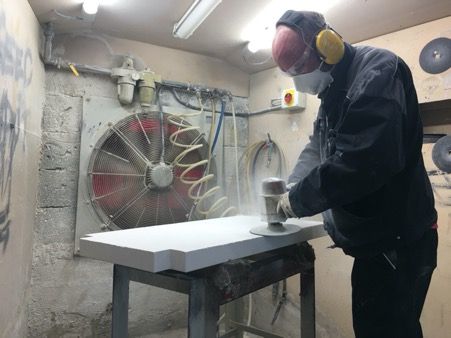Workplace Exposure Assessments
Many substances used within the workplace can cause harm to health. These substances could be dusts, vapours, gases, fibres or fumes. Ill health caused by these substances is preventable.
What does an Occupational Hygienist do?
Occupational Hygiene, or Industrial Hygiene (IH) as it’s also referred as is a science and engineering discipline used to control health hazards at work.
The aim of the occupational hygienist is to prevent and protect the workforce from exposures that result in serious and even fatal illnesses including:
-
Cancer
Asthma
Dermatitis
Hygienist can help in several ways including:
-
Identifying substances used on site where there is a potential for exposure which might result in harm.
-
Identify jobs or tasks the lead to exposure.
-
Reviewing the legal requirements.
-
Assisting site implement the principles of good practice for control of exposure to substances hazardous to health.
-
Developing a workplace monitoring plan to confirm operator’s personal exposure levels and current control measures.
-
Advise on additional control measures to reduce exposures.
The law requires companies to adequately control exposures to materials in the workplace that cause ill health.
These are laid out in The Control of Substances Hazardous to Health (COSHH) Regulations 2002 (as amended).
Within the workplace we refer to the person who has the legal responsibilities or obligations regarding compliance with COSHH as the Duty Holder (DH).
What is a substance hazardous to health?
COSHH applies to a wide range of substances and mixtures of substances which have the potential to cause harm to health. They can occur in many forms, including solids, liquids, vapours, gases and fumes. They can also be asphyxiants or biological agents.
Risk Assessment (and the Hierarchy of Control)
An employer shall not carry out work which is liable to expose any employees to any substance hazardous to health unless he has:
“made a suitable and sufficient assessment of the risk created by that work to the health of those employees and of the steps that need to be taken to meet the requirements of these Regulations”
Failing to correctly identify those at risk, the process or hazardous substances under control correctly can have disastrous consequences.
It is vital that the person undertaking the risk assessment is competent to do so.
The Control of Substances Hazardous to Health (COSHH) Approved Code of Practice and Guidance (ACOP) L5 (6th edition) 2013 covers the preferred or recommended methods that the Duty Holders can use to comply with the Regulations.
Prevent or Control Exposures to Substances Hazardous to Health
“Every employer shall ensure that the exposure of his employees to substances hazardous to health is either prevented or, where this is not reasonably practicable, adequately controlled.”
The Hierarchy of Control
The hierarchy of control is a systematic approach used to minimise or eliminate exposure to hazards in the workplace.
It prioritises control methods based on their effectiveness and can be represented visually in the table below with elimination the most effective and PPE the least effective as its only protects the user and can fail to danger.
LEV is one of the most common engineering control solutions provided in the workplace.
Adequate control for exposure by inhalation
Workplace Exposure Limits (WELS)
HSE has established WELs for a number of substances hazardous to health. These are intended to prevent excessive exposure to specified hazardous substances by containing exposure below a set limit. A WEL is the maximum concentration of an airborne substance averaged over a reference period to which employees may be exposed by inhalation.
WELs should not be considered a hard and fast line between safe and unsafe. The principles of good control practice require the degree to which exposure is reduced below the WEL to be proportionate to the health risk. If employers apply the principles of good practice for the control of substances hazardous to health correctly, exposure should be below any relevant WEL.
WELs refer to concentrations of hazardous substances in the air that people breathe, averaged over a specified period of time referred to as a time-weighted average (TWA). Two time periods are used: long-term (eight hours), and short-term (15 minutes).
HSE’s publication EH40/2005 Workplace exposure limits includes the list of substances assigned a WEL.
To comply with the requirements in regulation 7, employers may have to carry out a programme of exposure monitoring in accordance with regulation 10, unless the risk assessment made under regulation 6 shows that the level of exposure is most unlikely ever to exceed the WEL.
Workplace Exposure Assessments for Airborne Hazardous Substances
The aim of the assessment is to undertake workplace air monitoring to:
-
To provide information to help the duty holder develop their risk assessment.
-
To determine compliance with the Workplace Exposure Limit (WEL), or other in-house limit.
-
To check the effectiveness of control measures eg Local Exhaust Ventilation.
-
To indicate the need for health surveillance.
Our Workplace Exposure Assessment is undertaken using our four-part process called:
“Air Control Review”
-
Stage 1: Sampling Plan
-
Stage 2: Visual Inspection
-
Stage 3: Technical Measurements
-
Stage 4: Report
Based on visual inspections and technical measurements, the tester will make a judgement as to whether the substance(s) hazardous to health are being adequately controlled.

Request a Consultation
Get in touch
The first stage is to, either give us a call on 0191 378 2164 or fill out the contact us form and we’ll get back in touch to discuss your requirements.
We will then arrange a visit to your site, or if we have sufficient information, we’ll put a clear proposal together for you, with no hidden costs.
All being well our competent consultants will then visit site to undertake the work and produce a comprehensive report, reviewing your control measures with concise recommendations.
We operate throughout the UK and Worldwide.






